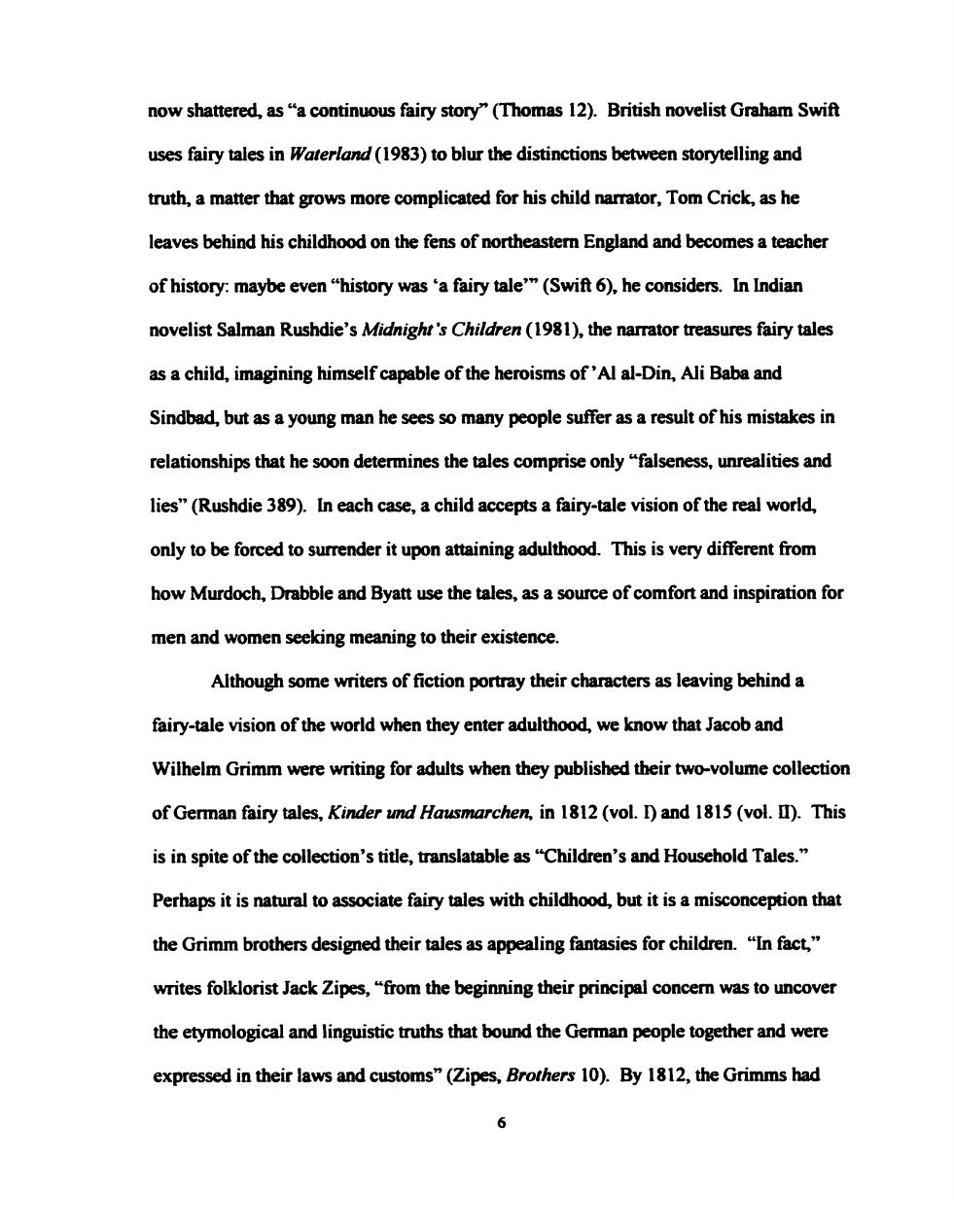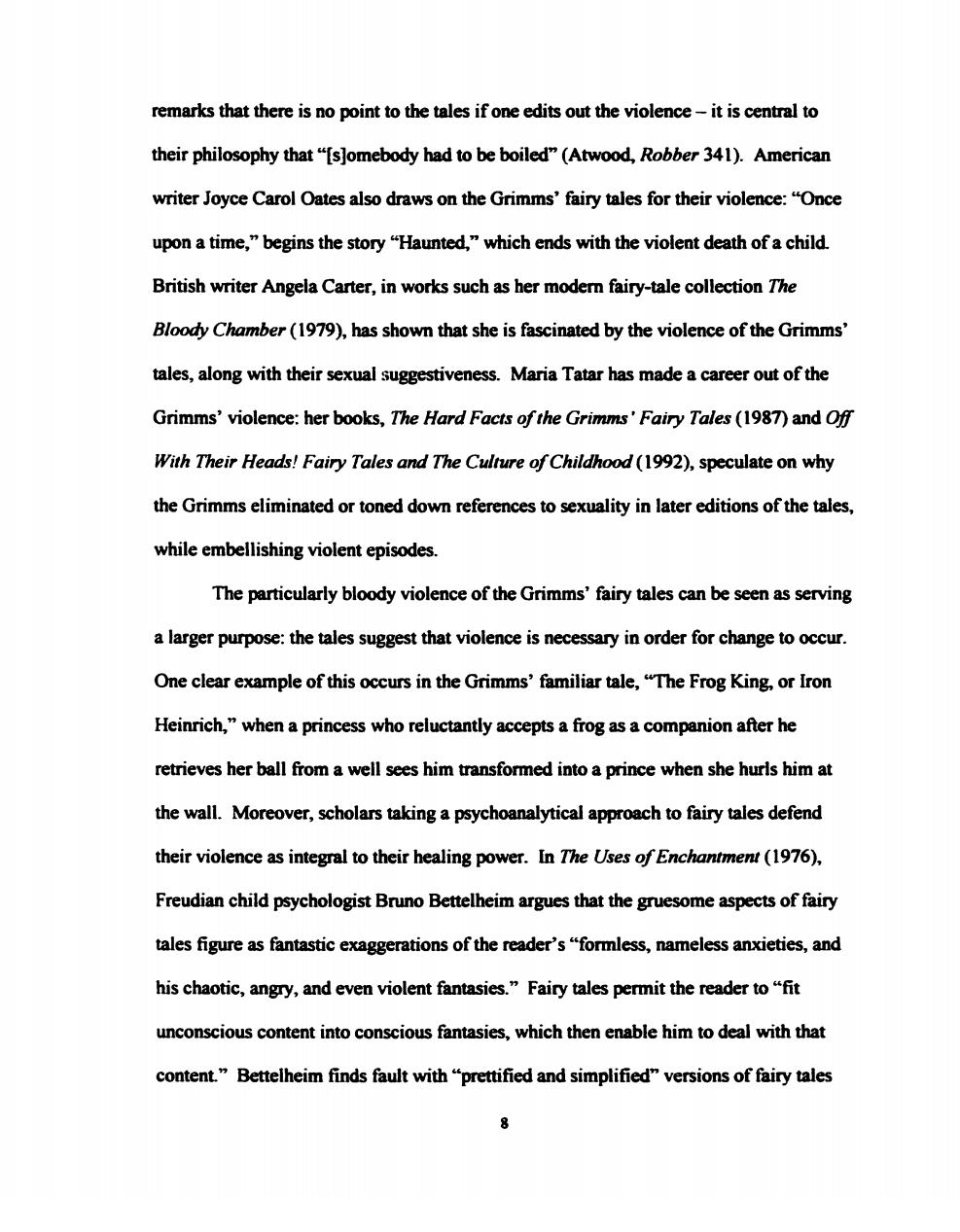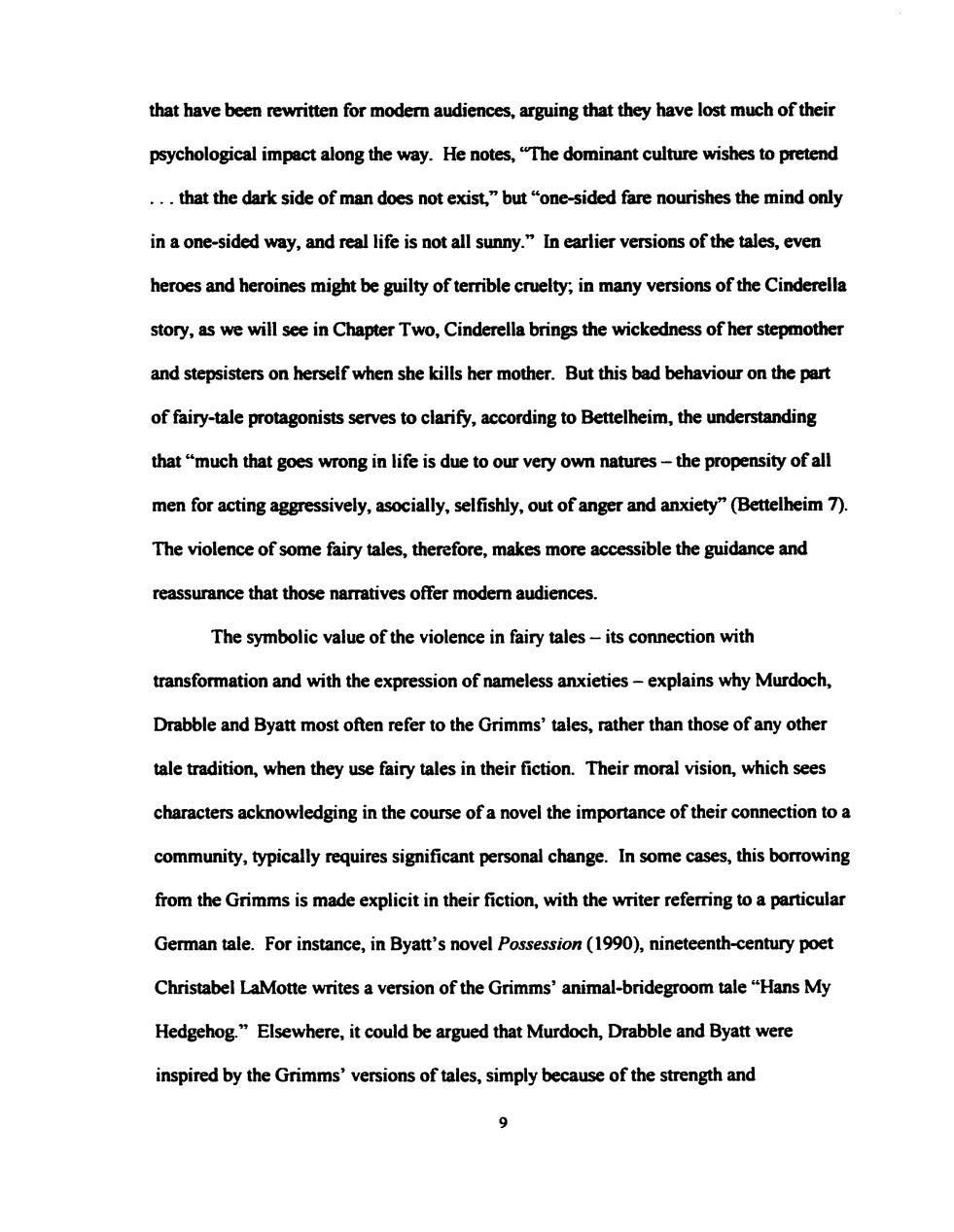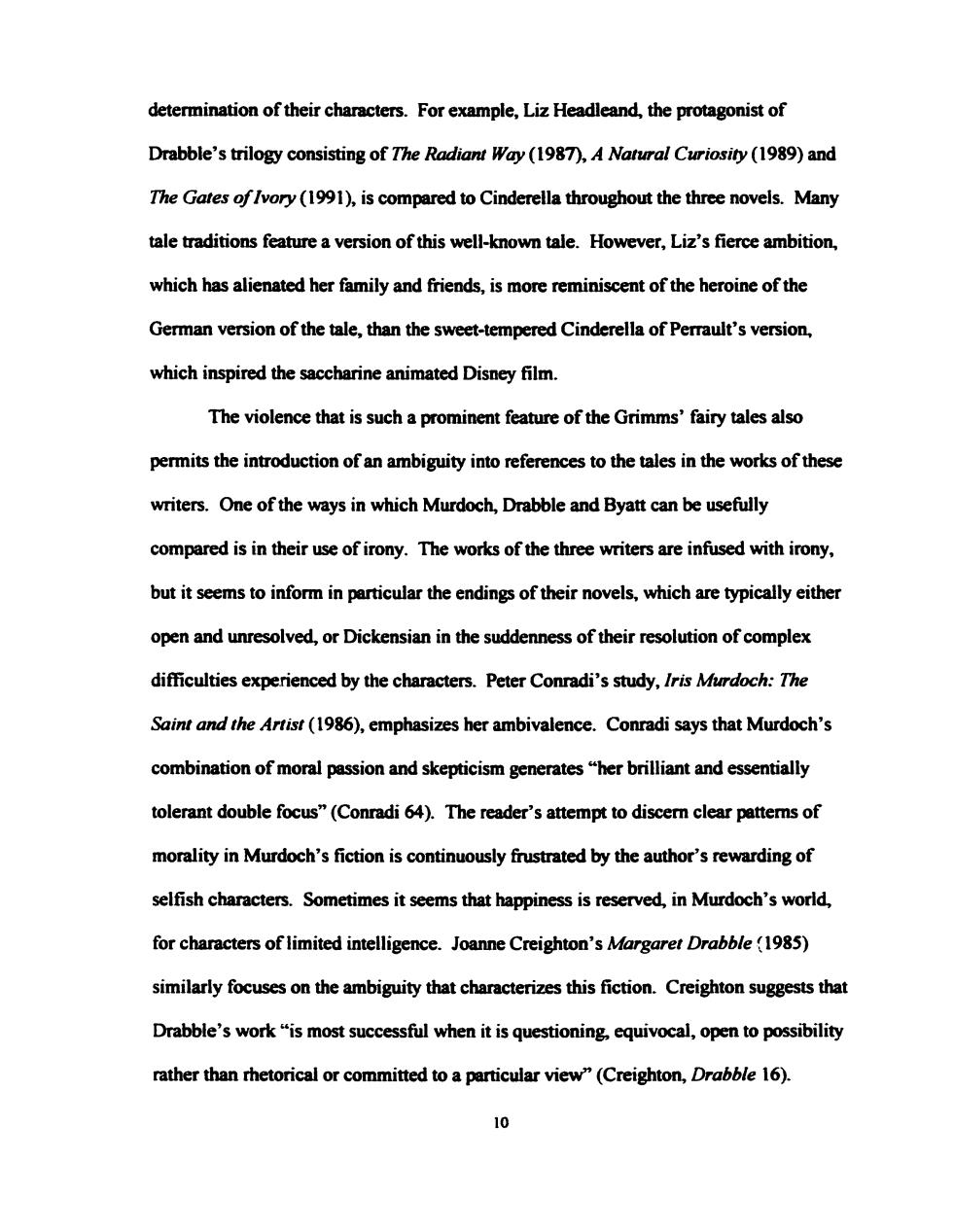
now shattered,as"a continuous fairy story"(Thomas 12).British novelist Graham Swift uses fairy tales in Waterland(1983)to blur the distinctions between storytelling and truth,a matter that grows more complicated for his child narrator,Tom Crick,as he leaves behind his childhood on the fens of northeastern England and becomes a teacher of history:maybe even"history was'a fairy tale'"(Swift 6),he considers.In Indian novelist Salman Rushdie's Midnight's Children(1981),the narrator treasures fairy tales as a child,imagining himself capable of the heroisms of'Al al-Din,Ali Baba and Sindbad,but as a young man he sees so many people suffer as a result of his mistakes in relationships that he soon determines the tales comprise only "falseness,unrealities and lies"(Rushdie 389).In each case,a child accepts a fairy-tale vision of the real world, only to be forced to surrender it upon attaining adulthood.This is very different from how Murdoch,Drabble and Byatt use the tales,as a source of comfort and inspiration for men and women seeking meaning to their existence. Although some writers of fiction portray their characters as leaving behind a fairy-tale vision of the world when they enter adulthood,we know that Jacob and Wilhelm Grimm were writing for adults when they published their two-volume collection of German fairy tales,Kinder und Hausmarchen,in 1812 (vol.I)and 1815(vol.DI).This is in spite of the collection's title,translatable as"Children's and Household Tales." Perhaps it is natural to associate fairy tales with childhood,but it is a misconception that the Grimm brothers designed their tales as appealing fantasies for children."In fact," writes folklorist Jack Zipes,"from the beginning their principal concern was to uncover the etymological and linguistic truths that bound the German people together and were expressed in their laws and customs"(Zipes,Brothers 10).By 1812,the Grimms had 6

already produced a German dictionary,a German grammar,and a book on ancient German law,among other scholarly,fact-based books and articles.They were known to other folklorists as"conscientious"researchers(Zipes,Brothers 10);as Zipes notes,they tried to make their version of the tales"as close to the oral tradition as possible"(12), although their editing process has fascinated folklorists.The Grimms were inspired in their work by nationalistic impulses,with the education of German children in the standards and expectations of their society a lesser aim.It was only as the popularity of the work among children and their guardians became evident,from about 1819 on,that editions were tailored more and more to appeal to a young audience. Modern readers who associate fairy tales with childhood will be surprised by some of the narratives'depictions of terrible cruelty.Weddings in fairy tales are typically celebrated alongside the punishment of those who tried to prevent them,with villains rolled downhill in barrels of nails or obliged to dance themselves to death in red- hot shoes.Although all fairy-tale traditions involve violence to some degree,the Grimms'tales are notorious for their particularly bloody violence.It seems that this has made them more interesting for some audiences than the more courtly French tales of Charles Perrault,for instance,which were very popular in England when they were translated into English in 1729(Opies 30).Italo Calvino has remarked on this aspect of the Grimms'tales in the Introduction to his edition of /talian Folktales,arguing that in Italian tales,"The continuous flow of blood that characterizes the Grimms'brutal tales is absent"(Calvino,Intro.xxix).The violence of the Grimms'tales has been their main point of interest for some writers.Canadian writer Margaret Atwood frequently draws on the Grimms'tales for their violence.In her novel The Robber Bride (1993),a character 7

remarks that there is no point to the tales if one edits out the violence-it is central to their philosophy that "[s]omebody had to be boiled"(Atwood,Robber 341).American writer Joyce Carol Oates also draws on the Grimms'fairy tales for their violence:"Once upon a time,"begins the story "Haunted,"which ends with the violent death of a child. British writer Angela Carter,in works such as her modern fairy-tale collection The Bloody Chamber(1979),has shown that she is fascinated by the violence of the Grimms" tales,along with their sexual suggestiveness.Maria Tatar has made a career out of the Grimms'violence:her books,The Hard Facts of the Grimms'Fairy Tales(1987)and Off With Their Heads!Fairy Tales and The Culture of Childhood(1992),speculate on why the Grimms eliminated or toned down references to sexuality in later editions of the tales, while embellishing violent episodes. The particularly bloody violence of the Grimms'fairy tales can be seen as serving a larger purpose:the tales suggest that violence is necessary in order for change to occur One clear example of this occurs in the Grimms'familiar tale,"The Frog King,or Iron Heinrich,"when a princess who reluctantly accepts a frog as a companion after he retrieves her ball from a well sees him transformed into a prince when she hurls him at the wall.Moreover,scholars taking a psychoanalytical approach to fairy tales defend their violence as integral to their healing power.In The Uses ofEnchantment(1976). Freudian child psychologist Bruno Bettelheim argues that the gruesome aspects of fairy tales figure as fantastic exaggerations of the reader's"formless,nameless anxieties,and his chaotic,angry,and even violent fantasies."Fairy tales permit the reader to"fit unconscious content into conscious fantasies,which then enable him to deal with that content."Bettelheim finds fault with"prettified and simplified"versions of fairy tales 8

that have been rewritten for moder audiences,arguing that they have lost much of their psychological impact along the way.He notes,"The dominant culture wishes to pretend ..that the dark side of man does not exist,"but"one-sided fare nourishes the mind only in a one-sided way,and real life is not all sunny."In earlier versions of the tales,even heroes and heroines might be guilty of terrible cruelty;in many versions of the Cinderella story,as we will see in Chapter Two,Cinderella brings the wickedness of her stepmother and stepsisters on herself when she kills her mother.But this bad behaviour on the part of fairy-tale protagonists serves to clarify,according to Bettelheim,the understanding that"much that goes wrong in life is due to our very own natures-the propensity of all men for acting aggressively,asocially,selfishly,out of anger and anxiety"(Bettelheim 7) The violence of some fairy tales,therefore,makes more accessible the guidance and reassurance that those narratives offer moder audiences The symbolic value of the violence in fairy tales-its connection with transformation and with the expression of nameless anxieties-explains why Murdoch, Drabble and Byatt most often refer to the Grimms'tales,rather than those of any other tale tradition,when they use fairy tales in their fiction.Their moral vision,which sees characters acknowledging in the course of a novel the importance of their connection to a community,typically requires significant personal change.In some cases,this borrowing from the Grimms is made explicit in their fiction,with the writer referring to a particular German tale.For instance,in Byatt's novel Possession(1990),nineteenth-century poet Christabel LaMotte writes a version of the Grimms'animal-bridegroom tale"Hans My Hedgehog."Elsewhere,it could be argued that Murdoch,Drabble and Byatt were inspired by the Grimms'versions of tales,simply because of the strength and

determination of their characters.For example,Liz Headleand,the protagonist of Drabble's trilogy consisting of The Radiant Way (1987),A Natural Curiosity (1989)and The Gates of /vory(1991),is compared to Cinderella throughout the three novels.Many tale traditions feature a version of this well-known tale.However,Liz's fierce ambition, which has alienated her family and friends,is more reminiscent of the heroine of the German version of the tale,than the sweet-tempered Cinderella of Perrault's version, which inspired the saccharine animated Disney film The violence that is such a prominent feature of the Grimms'fairy tales also permits the introduction of an ambiguity into references to the tales in the works of these writers.One of the ways in which Murdoch,Drabble and Byatt can be usefully compared is in their use of irony.The works of the three writers are infused with irony, but it seems to inform in particular the endings of their novels,which are typically either open and unresolved,or Dickensian in the suddenness of their resolution of complex difficulties experienced by the characters.Peter Conradi's study,Iris Murdoch:The Saint and the Artist(1986),emphasizes her ambivalence.Conradi says that Murdoch's combination of moral passion and skepticism generates"her brilliant and essentially tolerant double focus"(Conradi 64).The reader's attempt to discern clear pattems of morality in Murdoch's fiction is continuously frustrated by the author's rewarding of selfish characters.Sometimes it seems that happiness is reserved,in Murdoch's world, for characters of limited intelligence.Joanne Creighton's Margaret Drabble(1985) similarly focuses on the ambiguity that characterizes this fiction.Creighton suggests that Drabble's work"is most successful when it is questioning,equivocal,open to possibility rather than rhetorical or committed to a particular view"(Creighton,Drabble 16). 10